Developing an app like AliPay can be a game-changer in the fintech industry.
AliPay, a leading digital wallet and payment platform, has set a high standard with its comprehensive features and robust security measures.
If you are considering creating a similar app, it is crucial to understand the costs involved.
On average, the cost to develop an app like AliPay ranges from $150,000 to $400,000. The estimate depends on various factors such as app complexity, features, development team location, and technology stack.
Investing in such a project can yield significant returns, given the increasing demand for digital payment solutions globally.
So, with this being said, let’s get right into it:
What is Alipay?
AliPay is a leading digital wallet.
The online payment platform was developed by Ant Financial, an affiliate of the Alibaba Group.
Launched in 2004, AliPay has revolutionized the way transactions are conducted, in China, by providing a secure and efficient platform for both online and offline payments.
It boasts over 1.3 billion users globally, making it one of the most used digital payment platforms in the world.
AliPay offers a wide range of services that go beyond simple money transfers.
Users can pay for goods and services online and offline, transfer money to friends and family, pay utility bills, and even invest in financial products directly through the app.
It supports multiple currencies, making it ideal for international transactions and travelers.
The app also integrates with various merchants, allowing seamless payments for online shopping, dining, transportation, and more.
One of the key features that sets AliPay apart is its robust security measures.
It employs advanced encryption technologies, biometric authentication, and real-time monitoring to ensure the safety of user data and transactions.
In addition to this, AliPay offers a consumer protection program that provides refunds for unauthorized transactions, further building user trust.
AliPay is known for its user-friendly interface, which makes it easy for users to navigate and do transactions quickly.
With continuous innovations and expansions, AliPay remains at the forefront of the digital payment industry.
Top Features of Alipay App
Creating an app like AliPay involves incorporating a variety of robust eWallet app features to ensure a seamless and secure user experience.
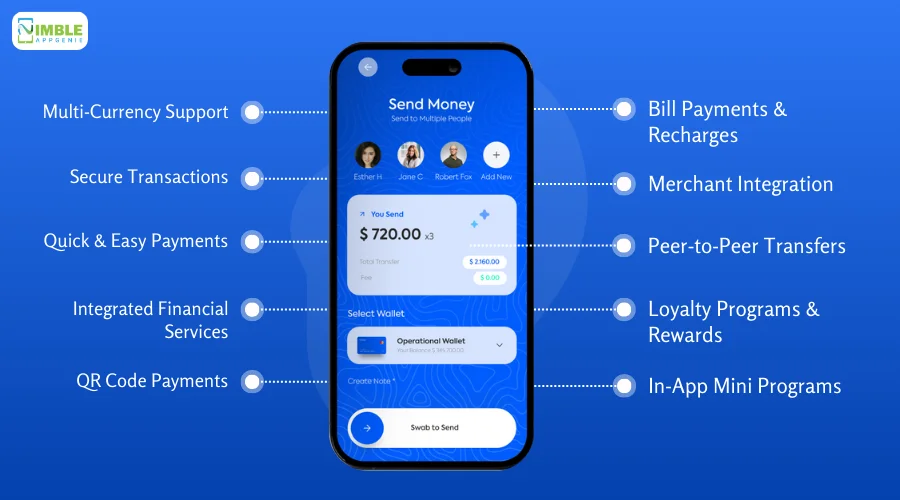
Here are the top features that make AliPay a leading digital wallet and payment platform:
♦ Multi-Currency Support
AliPay allows users to hold, transfer, and transact in multiple currencies. This feature is crucial for international travelers and businesses, eliminating the need for separate currency conversion services.
♦ Secure Transactions
AliPay employs advanced security measures including encryption, biometric authentication (such as fingerprint and facial recognition), and real-time transaction monitoring. These features ensure that user data and transactions are protected from unauthorized access.
♦ Quick and Easy Payments
Users can make mobile payments quickly and easily both online and offline. Whether paying for e-commerce purchases, utility bills, or in-store transactions, AliPay provides a seamless payment experience.
♦ Integrated Financial Services
AliPay offers a range of financial services such as savings accounts, investment products, insurance, and loans. This integration allows users to manage their finances comprehensively within a single app.
♦ QR Code Payments
AliPay’s QR code payment system enables fast and convenient in-store transactions. Users can simply scan a merchant’s QR code or present their own QR code to be scanned, making the payment process quick and efficient.
♦ Bill Payments and Recharges
Users can pay utility bills, recharge their mobile phones, and pay for various other services directly through the app. This convenience saves time and makes financial management easier.
♦ Merchant Integration
AliPay is a merchant service provider that integrates with a wide range of merchants, allowing users to make payments for online shopping, dining, transportation, and more. This extensive merchant network enhances the app’s utility and user convenience.
♦ Peer-to-Peer Transfers
Users can easily transfer money to friends and family within the app. This feature supports instant transfers, making it a popular choice for quick and easy money transfers.
♦ Loyalty Programs and Rewards
AliPay includes loyalty programs and rewards, offering users cashback, discounts, and other incentives. These programs encourage user engagement and retention.
♦ In-App Mini Programs
AliPay supports mini-programs within the app, allowing users to access third-party services without leaving the AliPay ecosystem. This feature enhances the app’s versatility and user engagement.
By integrating these features, an app like AliPay can provide a comprehensive, secure, and user-friendly financial solution that meets the diverse needs of its users.
Why Develop an App Like AliPay?
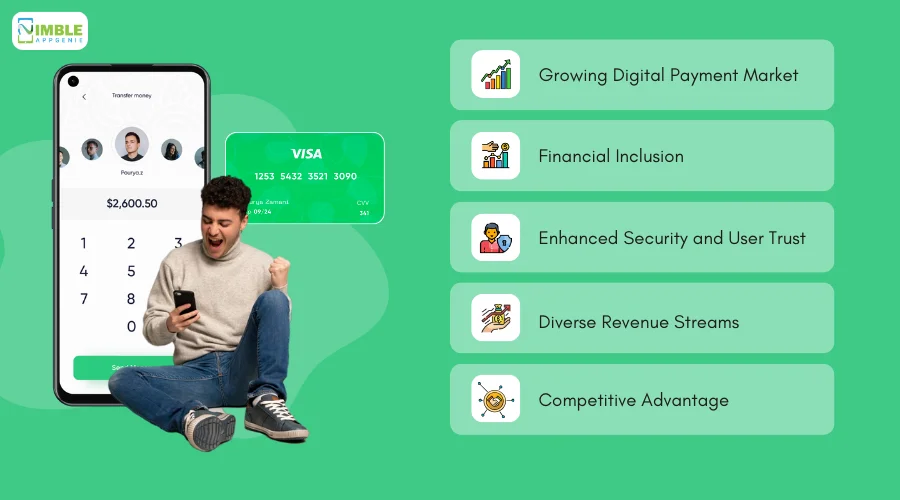
Why start an eWallet business in 2025?
Well, developing an app like AliPay can offer significant advantages for companies, investors, and startups.
Let’s look at five reasons to invest in creating such an app, supported by recent statistics and trends:
1. Growing Digital Payment Market
The eWallet market is expanding rapidly worldwide, driven by the increasing adoption of smartphones and internet connectivity.
According to Statista, the transaction value of the global digital payments market is expected to reach USD 10.52 trillion by 2025, growing at a CAGR of 12.8% from 2020 to 2025.
Developing a digital wallet app like AliPay positions you to capitalize on this growing market and caters to the rising demand for convenient and secure payment solutions.
2. Financial Inclusion
Digital wallets play a crucial role in enhancing financial inclusion by providing access to financial services for the unbanked and underbanked populations.
According to the World Bank, around 1.7 billion adults globally remain unbanked.
An app like AliPay can bridge this gap by offering easy-to-use financial services, such as peer-to-peer transfers, bill payments, and access to microloans, thereby reaching a wider audience and promoting financial inclusion.
3. Enhanced Security and User Trust
Security is a top priority for users when it comes to digital payments.
AliPay’s advanced security features, including biometric authentication and real-time monitoring, have set a high standard in the industry.
By developing an app with robust security measures, you can build user trust and attract a loyal customer base.
A survey by PwC indicates that 85% of consumers are more likely to use digital payment services that focus on security.
4. Diverse Revenue Streams
Alipay like app that offers multiple monetization opportunities, including transaction fees, currency conversion fees, subscription plans, and partnerships with merchants.
For example, AliPay charges a small fee for each transaction, which, given the high transaction volume, translates into large revenue.
According to Juniper Research, digital wallet transaction values are expected to surpass USD 10 trillion by 2025, offering significant revenue potential for digital wallet providers.
5. Competitive Advantage with Advanced Features
Integrating advanced features for fintech apps such as multi-currency support, QR code payments, and in-app financial services can differentiate your app in the competitive digital wallet market.
AliPay’s continuous innovation and expansion into various financial services have made it a market leader. By incorporating similar advanced features, you can attract a diverse user base and stay ahead of the competition.
A report by McKinsey & Company highlights that digital wallets with comprehensive features and user-friendly interfaces are more likely to succeed in the market.
Developing an app like AliPay not only meets the current market demand but also positions you for future growth and success in the fintech industry. By offering a secure, user-friendly, and feature-rich digital wallet, you can attract a broad user base and generate significant returns on investment.
Average Cost to Develop an App Like AliPay
So, what’s cost to develop an ewallet app involved in this venture?
Developing an app like AliPay involves a significant investment, given the advanced features and robust security measures required.
On average, the cost to develop an app like AliPay ranges from $150,000 to $400,000.
The estimate depends on various factors such as app complexity, features, development team location, and the technology stack used.
Here’s a brief breakdown of the cost components:
| Development Component | Estimated Cost Range |
| 1. UI/UX Design | $15,000 – $30,000 |
| 2. Frontend Development | $25,000 – $50,000 |
| 3. Backend Development | $40,000 – $80,000 |
| 4. API Integration | $20,000 – $40,000 |
| 5. Security Features | $20,000 – $40,000 |
| 6. Testing & QA | $15,000 – $30,000 |
| 7. Deployment | $10,000 – $20,000 |
| 8. Maintenance | $10,000 – $20,000/year |
The cost can vary based on the specific requirements and complexity of your app.
Investing in a quality development process ensures a robust, secure, and user-friendly app, ultimately contributing to its success in the market.
Factors That Affect AliPay Clone Development Cost
Developing an app like AliPay involves several intricate factors that can significantly influence the overall mobile app development cost.
Each of these factors plays a critical role in determining the complexity and resources required for development.
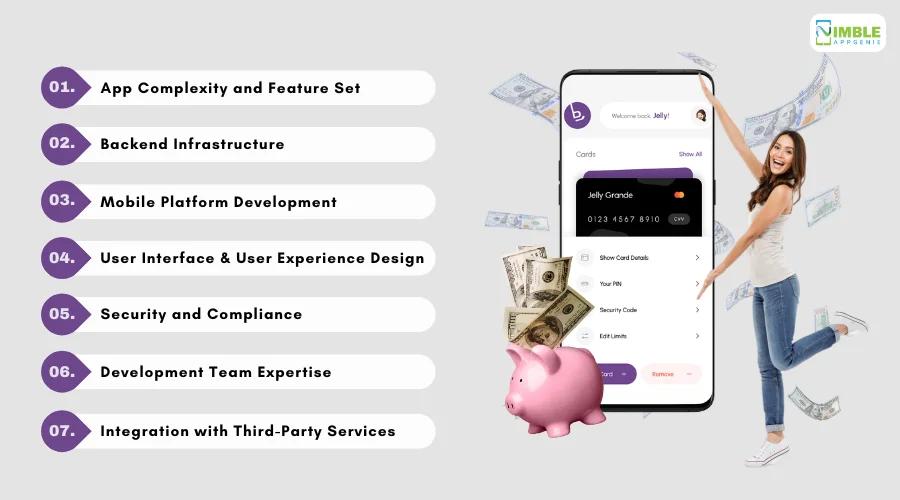
Here’s a detailed breakdown of the major factors:
1] App Complexity and Feature Set
The complexity of the app and the number of features included are the primary cost drivers.
Basic features such as user registration, balance checks, and simple money transfers will cost less than advanced features like multi-currency support, cryptocurrency integration, AI-driven analytics, and real-time fraud detection.
The more complex the features, the higher the development cost due to increased development time and resources needed.
Each additional feature requires extensive coding, integration, and testing to ensure seamless functionality.
| Features | Estimated Additional Cost | Description |
| Basic Features | $50,000 – $70,000 | Essential functionalities such as user authentication and basic payment capabilities. |
| Advanced Security Features | $10,000 – $20,000 | Includes biometric authentication, encryption, and real-time fraud detection. |
| Cryptocurrency Integration | $15,000 – $30,000 | Infrastructure to support cryptocurrency transactions and compliance with regulations. |
| AI & Analytics | $20,000 – $40,000 | AI-driven features for personalized recommendations and transaction analysis. |
| Multi-Currency Support | $10,000 – $20,000 | Features to handle multiple currencies, ensuring seamless conversion and transactions. |
2] Backend Infrastructure
The backend infrastructure is the backbone of any fintech app.
This includes servers, databases, and digital wallet APIs that handle data storage, user authentication, transaction processing, and more.
A robust backend is essential for ensuring the app’s reliability, security, and scalability.
Investing in a strong backend infrastructure is crucial for supporting a large number of users and transactions, which adds to the Alipay clone development cost.
Using scalable solutions like cloud services can also impact the budget but provide long-term benefits.
| Backend Components | Estimated Additional Cost | Description |
| Server Setup and Maintenance | $10,000 – $20,000 | Secure and scalable servers to handle app operations. |
| Database Management | $5,000 – $10,000 | Robust solutions for secure data storage and efficient retrieval. |
| API Development and Integration | $10,000 – $30,000 | Develop APIs for third-party service integrations like payment gateways and notification services. |
3] Mobile Platform Development
Developing an eWallet app for multiple platforms (iOS and Android) can significantly affect the cost.
Each platform requires a separate development process due to different programming languages (Swift for iOS and Kotlin/Java for Android) and design guidelines.
Developing a native app for both platforms increases development time and cost but ensures a seamless user experience.
Cross-platform development frameworks like React Native can reduce costs but might compromise performance.
| Platform | Estimated Added Cost | Description |
| iOS | $20,000 – $40,000 | Develop for Apple devices using Swift or Objective-C. |
| Android | $20,000 – $40,000 | Development for Android devices using Kotlin or Java. |
| Cross-Platform | $30,000 – $50,000 | Using frameworks like React Native or Flutter to develop a single codebase for both platforms. |
4] User Interface and User Experience (UI/UX) Design
A well-designed UI/UX enhances user satisfaction and engagement.
This involves creating wireframes, prototypes, and final designs, as well as conducting usability tests to ensure the app is intuitive and user-friendly.
Investing in high-quality UI/UX design can increase upfront costs but leads to higher user retention and satisfaction, making it a worthwhile investment.
| Design Complexity | Estimated Cost | Description |
| Basic Design | $10,000 – $15,000 | Initial wireframes and basic visual elements. |
| Advanced Design | $20,000 – $30,000 | Detailed visual elements, prototypes, and extensive usability testing. |
5] Security and Compliance
Ensuring that the app complies with financial regulations and security standards is crucial.
This includes implementing encryption, secure user authentication, and compliance with regulations such as PCI-DSS and GDPR.
Security and compliance measures add to the development cost but are essential to avoid legal issues and ensure user trust. Regular security audits and updates are also necessary.
| Compliance Level | Estimated Cost | Description |
| Basic Compliance | $10,000 – $20,000 | Implement basic security measures and compliance with primary regulations. |
| Full Compliance | $30,000 – $50,000 | Comprehensive security measures and adherence to all relevant financial regulations. |
6] Development Team Expertise
To develop an eWallet app like AliPay, you first need to hire app developers.
The expertise of the development team plays a significant role in the project’s cost.
Experienced developers with a strong background in fintech app development can command higher rates but also bring valuable expertise and efficiency to the project.
Hiring experienced developers ensures a high-quality app but increases the overall cost. Balancing cost with quality is essential for the project’s success.
| Developer Expertise | Estimated Hourly Rate | Description |
| Junior Developers | $30 – $50/hour | Suitable for less complex tasks and support roles. |
| Mid-Level Developers | $50 – $80/hour | Good balance of cost and expertise for most development tasks. |
| Senior Developers | $80 – $150/hour | Essential for critical and complex components of the app. |
7] Integration with Third-Party Services
Integrating third-party services such as payment gateway integration, SMS notifications, and geolocation services can add to the app’s functionality but also increase the cost to make an app like AliPay.
Each integration requires specific API development and testing to ensure seamless operation.
The more third-party services integrated into the app, the higher the development cost due to the need for specialized coding and testing.
| Third-Party Services | Estimated Cost | Description |
| Payment Gateway Integration | $10,000 – $20,000 | Ensuring secure and seamless payment processing through APIs. |
| SMS Notification Integration | $5,000 – $10,000 | Implementing services for sending transaction alerts and notifications. |
| Geolocation Services | $5,000 – $15,000 | Adding features that require location data, such as finding nearby merchants. |
By considering these detailed factors, you can better understand how they influence the overall cost to develop an app like AliPay and make informed decisions to manage your budget effectively.
How Long Does It Take to Develop an AliPay-Like App?
The development timeline for an app like AliPay depends on various factors, including the app’s complexity, features, and the efficiency of the development team.
On average, developing a fully functional AliPay-like app can take anywhere from 6 to 12 months.
Here’s a detailed breakdown of the eWallet development time required for each:
| Development Stages | Estimated Timeframe |
| 1. Requirement Analysis & Planning | 3 – 5 weeks |
| 2. UI/UX Design | 5 – 7 weeks |
| 3. Frontend & Backend Development | 16 – 24 weeks |
| 4. Integration of Features & APIs | 5 – 8 weeks |
| 5. Testing & Quality Assurance | 4 – 6 weeks |
| 6. Deployment & Launch | 2 – 3 weeks |
| 7. Post-Launch Support & Maintenance | Ongoing |
By following this timeline, you can ensure that the development process is smooth and efficient, leading to the successful launch of your AliPay-like app.
How to Decrease Time & Cost Without Affecting App Clone Quality?
Developing an app like AliPay efficiently requires strategic planning and smart implementation.
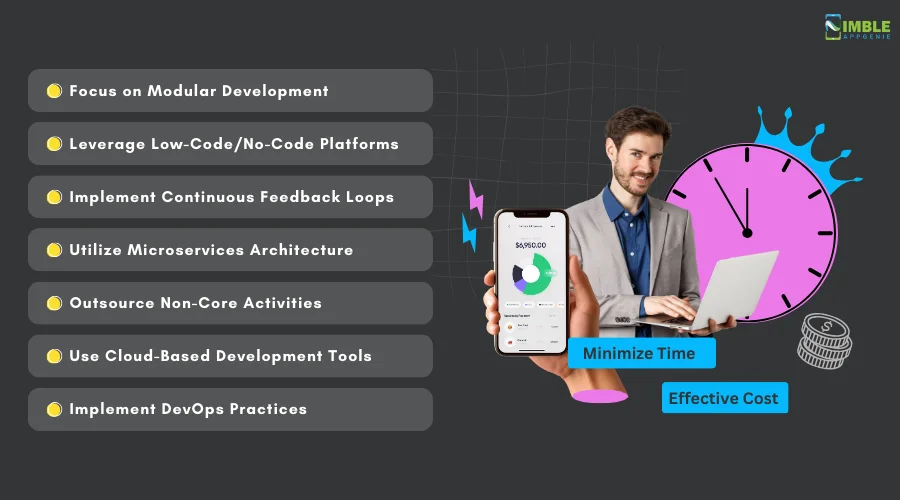
Here are some unique strategies to reduce time and cost without compromising on quality:
► Focus on Modular Development
Breaking down the development process into smaller, manageable modules can streamline the workflow and make it easier to manage and integrate new features.
How to Carry out Modular Development:
- Divide Features: Break down the app features into distinct modules.
- Parallel Development: Develop modules to save time.
- Reuse Code: Use existing code libraries and frameworks where possible.
► Leverage Low-Code/No-Code Platforms
Utilizing low-code or no-code platforms can significantly speed up the development process by allowing rapid prototyping and iteration.
Examples:
- Low-Code Platforms: Use platforms like OutSystems or Mendix for rapid application development.
- No-Code Solutions: Employ tools like Bubble or Adalo to build functional prototypes quickly.
► Carry out Continuous Feedback Loops
Regularly gathering feedback from stakeholders and early users can help identify issues and areas for improvement early in the development cycle.
Steps to Carry out Continuous Feedback:
- User Testing: Conduct regular user testing sessions.
- Stakeholder Reviews: Schedule frequent reviews with stakeholders.
- Iterative Improvements: Incorporate feedback into the development process continuously.
► Using Microservices Architecture
Using microservices architecture allows for independent deployment and scaling of different app components, enhancing flexibility and reducing development time.
Key Steps:
- Decoupling Services: Break down the app into smaller, independent services.
- Independent Deployment: Deploy and scale services independently.
- Enhanced Flexibility: Adapt and update individual services without affecting the entire app.
► Outsource Non-Core Activities
Non-core activities like testing, maintenance, or specific feature development can be outsourced to fintech developers. This will help focus on core functionalities and reduce costs.
Considerations for Outsourcing:
- Select Reputable Partners: Choose outsourcing partners with a strong track record.
- Clear Communication: Maintain clear and regular communication channels.
- Focus on Core Development: Allow your in-house team to focus on critical features.
► Using Cloud-Based Development Tools
Cloud-based development tools offer scalable resources and collaborative features, which can speed up the development process and reduce costs.
Recommended Tools:
- Cloud IDEs: Use tools like AWS Cloud9 or Gitpod for cloud-based development environments.
- Collaboration Tools: Employ platforms like Slack or Microsoft Teams for team collaboration.
- Scalable Infrastructure: Utilize cloud services like AWS, Google Cloud, or Azure for scalable backend infrastructure.
► Implement DevOps Practices
Adopting DevOps practices can enhance collaboration between development and operations teams, streamline workflows, and speed up deployment.
Implementation Steps:
- Automated Pipelines: Set up automated CI/CD pipelines using tools like Jenkins or GitLab CI.
- Continuous Monitoring: Carry out continuous monitoring to quickly identify and resolve issues.
- Infrastructure as Code: Use tools like Terraform to manage infrastructure through code, ensuring consistency and repeatability.
By following these strategies, you can effectively minimize the time and cost to develop an app like AliPay while maintaining high-quality standards. These practices streamline the development process by ensuring your app is robust, scalable, and ready to meet market demands.
Monetization Strategies for Great ROI
Developing an app like AliPay offers numerous e-wallet app monetization opportunities that can generate large revenue.
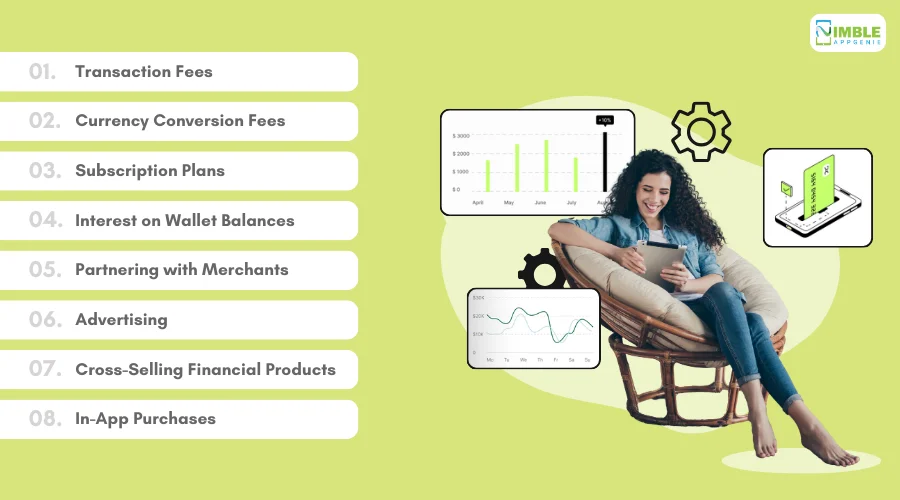
Here are some effective monetization strategies along with their revenue generation potential:
1. Transaction Fees
Charging a small fee for each transaction is a primary revenue source for payment apps like AliPay. These fees can apply to money transfers, currency exchanges, and payment processing.
Revenue Potential: High. With thousands of transactions processed daily, even a small fee can accumulate to a large income.
Example: If the app processes 100,000 transactions per day with an average fee of $0.50, it can generate $50,000 daily.
2. Currency Conversion Fees
When users make transactions involving different currencies, a currency conversion fee may be applied. AliPay charges a markup on the exchange rate for such transactions, making it a profitable feature.
Revenue Potential: Moderate to High. The global nature of digital wallets means frequent currency conversions, leading to consistent revenue.
Example: If the app charges a 2% fee on currency conversions and processes $1 million in conversions daily, it generates $20,000 daily.
3. Subscription Plans
Offering premium services through subscription plans can attract users who need advanced features or higher transaction limits. For instance, providing faster transaction speeds, lower fees, or additional security measures for a monthly or annual fee can be lucrative.
Revenue Potential: Moderate. Subscription models ensure a steady income stream and can significantly boost revenue with a large user base.
Example: If 10,000 users subscribe to a premium plan at $10/month, the app generates $100,000 monthly.
4. Interest on Wallet Balances
Keeping users’ funds in digital wallets allows the app to earn interest from financial institutions. This interest can be a significant revenue source if the app manages large volumes of user funds.
Revenue Potential: Moderate to High. The more users keep their money in the wallet, the higher the interest income.
Example: If the app holds $10 million in user funds with an interest rate of 1% per annum, it generates $100,000 annually in interest.
5. Partnering with Merchants
By partnering with online merchants and offering cashback or discounts to users, the app can earn a commission on each sale. This not only drives user engagement but also provides a steady revenue stream.
Revenue Potential: Moderate. Strategic partnerships with popular merchants can boost transactions and, therefore, commissions.
Example: If the app partners with 50 merchants and earns an average commission of 5% on $500,000 monthly sales, it generates $25,000 monthly.
6. Advertising
Displaying targeted ads within the app can generate added revenue. Using user data to show relevant ads can enhance the click-through rate and overall ad revenue.
Revenue Potential: Moderate. While advertising can be lucrative, it should be balanced to avoid compromising user experience.
Example: If the app has 1 million active users and generates $2 per user per month in ad revenue, it earns $2 million monthly.
7. Cross-Selling Financial Products
Offering additional financial services such as loans, insurance, or investment products can open up new revenue streams. Partnering with financial institutions to cross-sell these products can earn commissions.
Revenue Potential: High. Cross-selling enhances user value and generates significant commissions from partner institutions.
Example: If the app earns a commission of $50 per cross-sold product and sells 1,000 products monthly, it generates $50,000 monthly.
8. In-App Purchases
Enabling in-app purchases for features like virtual cards, higher withdrawal limits, or enhanced security options can attract users willing to pay for added convenience and security. Develop
Revenue Potential: Low to Moderate. While not all users will opt for in-app purchases, it provides an extra revenue channel.
Example: If 5% of 1 million users make in-app purchases worth $10 each monthly, the app generates $500,000 monthly.
By implementing these monetization strategies, you can ensure a great return on investment for your AliPay-like app. Each strategy leverages different aspects of the app’s functionality and user behavior, providing multiple revenue streams and enhancing overall profitability.
Nimble AppGenie – Your Partner in eWallet Market Success
As a leading eWallet app development company, Nimble AppGenie excels in creating innovative, secure, and user-friendly financial applications.
Our expert team leverages cutting-edge technology and industry best practices to deliver top-notch apps that enhance user experience and ensure seamless financial transactions.
Whether you’re looking to develop an app like Alipay or any other digital wallet, our comprehensive services cover everything from conceptualization and design to development and maintenance.
We are committed to driving your fintech success and helping you achieve your business goals with a reliable and robust eWallet solution.
Conclusion
Developing an app like AliPay offers significant opportunities in the rapidly growing digital payment landscape. By understanding the costs, essential features, and effective monetization strategies, businesses can create a robust, user-friendly, and profitable eWallet solution.
Partnering with an experienced app development company like Nimble AppGenie ensures that your project is handled with expertise and precision, paving the way for your success in the competitive fintech market.
FAQs
The estimated cost to develop an app like AliPay ranges from $150,000 to $400,000, depending on complexity and features.
On average, it takes 6 to 12 months to develop an app like AliPay, including planning, design, development, and testing.
Key features include multi-currency support, secure transactions, QR code payments, integrated financial services, peer-to-peer transfers, and loyalty programs.
Factors include app complexity, backend infrastructure, mobile platform development, UI/UX design, security and compliance, development team expertise, and integration with third-party services.
Adopting Agile methodology, using pre-built solutions, outsourcing non-core activities, focusing on MVP, automating testing, utilizing cloud services, and implementing CI/CD practices can help minimize time and cost.
Monetization strategies include transaction fees, currency conversion fees, subscription plans, interest on wallet balances, partnering with merchants, advertising, cross-selling financial products, and in-app purchases.
Essential security measures include advanced encryption, biometric authentication, real-time transaction monitoring, and compliance with regulations like PCI-DSS and GDPR.

Niketan Sharma is the CTO of Nimble AppGenie, a prominent website and mobile app development company in the USA that is delivering excellence with a commitment to boosting business growth & maximizing customer satisfaction. He is a highly motivated individual who helps SMEs and startups grow in this dynamic market with the latest technology and innovation.
Table of Contents




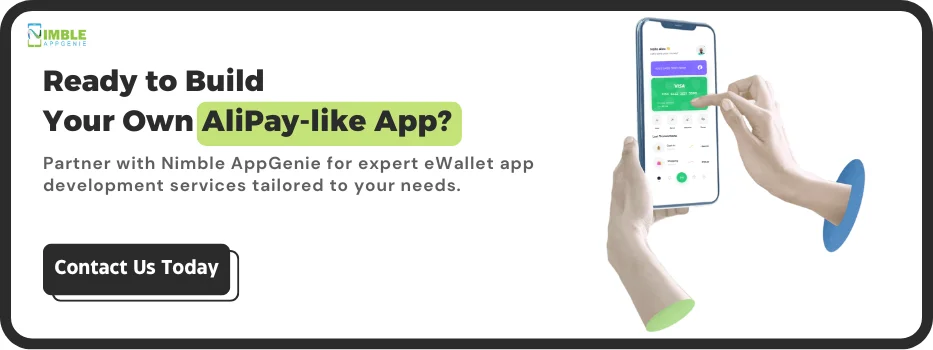
No Comments
Comments are closed.